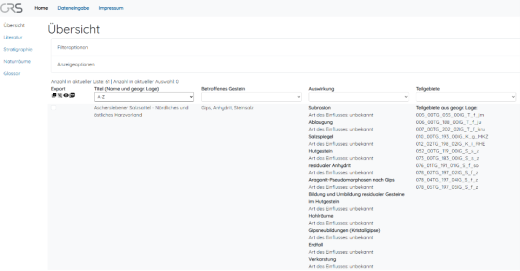Effects of subrosion on a potential repository in salt rock

Subrosion, i.e. the leaching of easily soluble rocks in the subsoil, can impair the barriers of a repository for high-level radioactive waste. In a recently completed research project, scientists at GRS investigated these processes and compiled affected areas and boundary conditions in a web application. Model calculations of groundwater flow help to better assess the long-term effects of subrosion on the containment of radionuclides in a repository system.
The German Site Selection Act stipulates that the so-called containment-providing rock zone of a repository in salt rock as host rock must retain its barrier function over an evaluation period of one million years. There are various processes and factors that can impair this barrier function.
These include the underground leaching and transport of mostly easily soluble rock (such as salt rock), which in geological terminology is referred to as subrosion. In a research project funded by the Federal Company for Radioactive Waste Disposal (BGE), scientists at GRS investigated such subrosion processes and their possible influences on a repository for high-level radioactive waste in salt rock.
Dedicated interactive web application developed
The first step was to systematically compile a list of areas affected by subrosion in Germany, including the factors influencing this process and the subrosion rates determined for salt structures in Germany.
To this end, extensive literature on subrosion phenomena in Germany was evaluated and incorporated into a specially developed interactive web application with an underlying database (see Figure 1).
Entries can be filtered according to various criteria
This web application lists the stratigraphic units (i.e. layers of earth) in which subrosion processes occur frequently, grouped according to their regional geological distribution. It contains 78 entries on geographical locations where subrosion phenomena have been observed and 270 entries on subrosion.
The web application can be used to filter entries according to various criteria, e.g. the stratigraphic unit affected by subrosion, the observed depth of subrosion, or information on the tectonics and genesis of the geological formation. This way, processes, factors and their interrelationships as well as possible influences on the subareas defined in the site selection process can be identified.
Groundwater flow model calculations
The extent of possible future subrosion processes can be investigated using groundwater models. In order to assess the potential impact of subrosion rates over the course of years up to millennia on a repository site in salt rock, the researchers performed model calculations of groundwater flow, using the GRS code d3f++ in a second step. In doing so, they had to take into account influencing factors such as density flow and the effects of climate change on subrosion.
Better assessment of radionuclide containment
The results of the investigations serve as a basis for better evaluating the containment of radionuclides in a repository system in salt rock as a host rock and for better assessing the possible influence of subrosion. The compilation of subrosion phenomena and their geographical distribution in the web application also provides a centralised source of information from the available literature.
The risks associated with various possible climate scenarios in Germany over the evaluation period were analysed by means of a qualitative assessment of the subrosion processes over the evaluation period. The quantitative assessment using numerical groundwater models supports the preceding qualitative analysis with model results. During the course of the work, open research issues and processes that are subject to unc
Sven Dokter
GRS gGmbH
sven.dokter@grs.de

